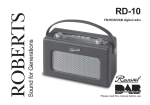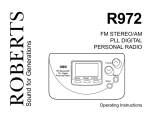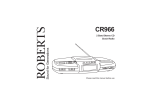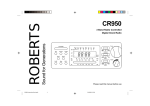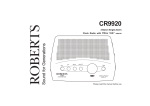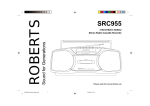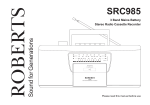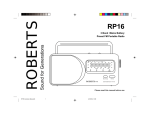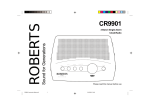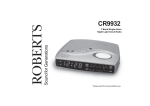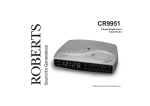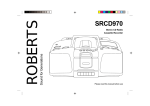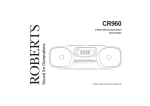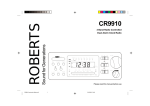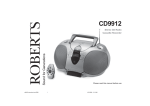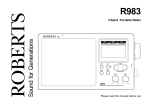Download Roberts CD9909 Specifications
Transcript
Sound for Generations ROBERTS CD9909 Stereo CD Radio Cassette Recorder Please read this manual before use 4 Controls 6 8 (on rear) 3 7 5 10 9 12 13 11 15 14 2 1. Tone control 16 17 2. Headphone socket 3. Tape/Radio/CD Function switch 4. Microphone socket 5. Volume control 6. Telescopic aerial 1 7. CD lid 8. CD repeat button 9. CD stop button 10. CD play/pause button 11. CD mix button 12. CD track F Skip and B Skip buttons 13. CD compartment open button 14. FM stereo indicator 15. Waveband switch 16. Tuning scale 17. Tuning control 18. Liquid crystal display 19. Stop/eject button 20. Fast forward button 21. Rewind button 24 22 22. Play button 20 23. Record button 25 (on rear) 23 21 19 18 24. Cassette door 25. Beat cut switch (on rear) IF IN DOUBT - CONSULT A QUALIFIED ELECTRICIAN. General Do not allow this unit to be exposed to water or steam. Do not leave the unit where excessive heat could cause damage. It is recommended that the FM band be used wherever possible as better results in terms of quality and freedom from interference will usually be obtained than on the MW or LW bands. Batteries Mains supply Reduced power, distortion, and a 'stuttering' sound are all signs that the batteries may need replacing. The CD9909 will operate from a supply of AC 230 volts, 50Hz only. For your convenience this product is supplied with a plug which is fitted with a fuse of the appropriate rating. If the plug supplied is not suitable for your socket outlet, it should be removed by unscrewing the plug top, the terminal screws, and removing the cable. Remove the battery cover on the rear of the unit by pushing the catches in the direction of the arrows. Insert eight IEC size LR20 batteries (D size) into the compartment. Take care to ensure all batteries are inserted with the correct polarity as shown inside the battery compartment. Replace the battery cover. We would recommend for economy, that the CD9909 is used on the mains whenever possible with battery operation for occasional or standby use only. The correct style of plug to suit your household together with a correctly rated fuse should be fitted. IF IN DOUBT - CONSULT A QUALIFIED ELECTRICIAN IMPORTANT. DO NOT make any connection to the larger terminal which is marked with the letter E or by the safety earth symbol or coloured Green or Green-and-yellow. The wires in the mains lead are coloured in accordance with the following codes :BLUE - NEUTRAL BROWN - LIVE As these colours may not correspond with the coloured markings identifying the terminals in your plug, proceed as follows: The wire coloured BLUE must be connected to the terminal marked N or coloured BLACK. The wire coloured BROWN must be connected to the terminal marked L or coloured RED. Fuse Automatic Mains/Battery switching To change from battery to mains operation, simply plug the mains lead into the mains input socket on the rear of the unit. The batteries will be automatically disconnected. It does not matter which way round the plug is inserted but make sure it is fully pushed home. The other end should be plugged into a domestic supply socket. This apparatus must be protected by a 3A fuse (BS1362) in a 13A plug (BS1363). If another type of plug is used a 5A fuse should be fitted in the plug, adaptor or distribution board. If you need any further advice, please call our Technical Helpline on 0181 758 0338 (Mon-Fri) Aerials The telescopic aerial (6) located on the rear of your CD radio cassette is for FM reception. The telescopic aerial should be fully extended and angled for optimum reception There is a built in ferrite aerial for MW and LW stations. Rotate your CD radio cassette to the position giving best reception. Radio operation (FM) Slide the Tape/Radio/CD switch (3) to the "Radio" position. Slide the waveband switch (15) to the “FM position”. Adjust the volume control (5) until a hissing sound is heard. Rotate the tuning control (17) until the desired station is received. If the station being received is in 'Stereo' the stereo indicator (14) will illuminate. Adjust the volume control (5) and tone control (1) to the required settings. To switch off the radio, slide the Tape/Radio/CD switch (3) to the "Off/Tape" position. Radio operation (MW and LW) Slide the Tape/Radio/CD switch (3) to the "Radio" position". Slide the waveband switch (15) to the “MW or LW” position. Adjust the volume control (5) until a hissing sound is heard. Rotate the tuning control (17) until the desired station is received. Adjust the volume control (5) and tone control (1) to the required settings. Rotate your CD radio cassette to the position giving best reception. To switch off the radio, slide the Tape/Radio/CD switch (3) to the "Off/Tape" position. CD operation Playing a disc Press the open button (13) to open the CD compartment. Carefully place a disc onto the spindle in the CD compartment, ensuring that the label is facing upwards. Close the lid ensuring it latches shut. Slide the Tape/Radio/CD switch (3) to the "CD" position. The Liquid crystal display (18) will light up if the unit is connected to the mains supply. Press the CD play/pause button (10) to play the disc. Adjust the volume control (5) and tone control (1) to the required settings. To switch off, slide the Tape/Radio/CD switch (3) to the "Off/ Tape" position. Pausing during CD play Whilst the CD is playing, press the CD play/pause button (10) to pause play. The disc will continue rotating, but play will stop and the track number will flash in the Liquid crystal display (18). To resume play, press the CD play/ pause button (10) again. The track number will stop flashing in the Liquid crystal display. Stopping CD play To stop CD play, press the stop button (9). The disc will stop rotating. Skip function Whilst the CD is playing, press either the F Skip or B Skip buttons (12) to change to the desired track. Search function Whilst the CD is playing, press and hold down either the F Skip or B Skip buttons (12). Release the button when the desired part of the track is reached. Repeat function To repeat only one track, press the repeat button (8) until the Liquid crystal display shows REPEAT 1. To repeat all tracks on a disc, press the repeat button (8) until the Liquid crystal display shows REPEAT. To cancel the repeat function, press the repeat button (8) until the word REPEAT 1 or REPEAT is removed from the Liquid crystal display. If you need any further advice, please call our Technical Helpline on 0181 758 0338 (Mon-Fri) Mixed play When mixed play is selected your CD radio cassette will play all the tracks on the disc in random order. Press the mix button (11) until the word ‘Mix’ appears in the display. All tracks on the disc will be played in a random order. Listening to cassette tapes Slide the Tape/Radio/CD switch (3) to the "Tape" position. Press the stop/ eject button (19) to open the cassette door (24). Insert a pre-recorded cassette with the tape surface nearest to the cassette keys and the side with the desired recording facing towards you. Close the cassette compartment. Depress the play button (22) and adjust the volume control (5) to suit your personal taste. Use the fast forward (20) or rewind buttons (21) to locate a specific part of the tape. When the end of tape is reached your CD radio cassette will automatically switch off. Recording from the Radio Slide the Tape/Radio/CD switch (3) to the "Radio" position. Tune in to the desired station. Adjust the volume control (5) to suit your requirements. Insert a blank cassette with the tape surface nearest to the cassette keys. Depress the record button (23) to commence recording. The recording level is set automatically and is not affected by the setting of the volume control. When recording from the MW or LW bands a whistle may occur. To remove the whistle slide the beat cut switch (25) on the rear of your CD radio cassette to the position giving best reception. Recording from CD Press the open button (13) to open the CD compartment. Carefully place a disc onto the spindle in the CD compartment, ensuring that the label is facing upwards. Close the lid ensuring it latches shut. Slide the Tape/Radio/CD switch (3) to the "CD" position. Insert a blank cassette with the tape surface nearest to the cassette keys. Select the required track using the F Skip or B Skip buttons (12). Press the record button (23) followed by the CD play/ pause button (10) to commence recording. Caution If the Record button will not depress, do not force it. It is probably because the cassette tabs have been broken to prevent accidental erasure of an existing recording (see preventing accidental erasure). Headphones A 3.5mm socket (2) on the top of your CD radio cassette is provided for use with stereo headphones. Inserting a plug into this socket automatically mutes the internal loudspeakers. External microphone A 3.5mm socket (25) located on the rear of your CD radio cassette is provided for use with external microphones. Inserting a plug into this socket will automatically mute the internal microphone. If you need any further advice, please call our Technical Helpline on 0181 758 0338 (Mon-Fri) Preventing accidental erasure To safeguard your recordings against accidental erasure, break off the appropriate tab on the cassette as shown . There is one tab for each side of the cassette. This will prevent the Record button from being pressed. To restore the cassette to normal, seal the tab openings with a small piece of self-adhesive tape. Safety tab side A Safety tab side B A Cleaning the Heads C 60 The binder and oxide from magnetic tapes can accumulate on the pinch roller (A) the capstan shaft (B) and also the heads (C and D). This will impair the sound quality. To clean these parts proceed as follows:1. Turn off the power to the unit. 2. Press the Stop/Eject button (19). 3. Press the Play button (22) and the heads will be clearly seen. 4. Clean the surfaces (A, B, C, D) with a lint free rag or cotton swab soaked in alcohol. Press the stop/eject button as soon as cleaning is over. Product Care Do not expose your CD radio cassette to extremes of temperature. The product should be kept in a warm environment free from dust and damp. For external cleaning use only a soft, clean cloth. Use a damp cloth to clean the plastic cabinet. A mild soap will help to remove grease or oil. Never use strong detergents or spray cleaners, abrasive powders, thinners or solvents on the machine, as these may cause damage the finish. CD Player Maintenance The player mechanism is fitted with self-lubricating bearings, and must not be oiled or greased. Cleaning compact discs While CDs do not ‘scratch’ the way vinyl records do, they are not indestructible. Although the music tracks on the disc are covered with a protective layer, it is still advisable to treat the disc carefully. As long as you always pick up discs by the edge, and put them back in their holders immediately after use, cleaning will not normally be necessary. However, should fingerprints, dust or dirt appear, you can wipe them off with a soft, lint-free cloth. Wipe the disc in a straight line from centre to edge. If the disc is heavily soiled use a commercially available CD cleaner. Detergent or abrasive cleaning agents must never be used. Never write on the disc label – this can cause irreparable damage to the disc. If you need any further advice, please call our Technical Helpline on 0181 758 0338 (Mon-Fri) Disc player Specifications Power Requirements Mains AC 230 volts, 50Hz Batteries 8 x LR20 (D size) only Laser wavelength 780nM Laser power 5mW max Frequency response 20Hz-20kHz (battery life approx. 25 hours) Radio Frequency Coverage General Output Power Loudspeakers Headphone socket 2 x 2W RMS FM 87.5 -108MHz 2 x 100mm dia 4ohms MW 530 - 1605kHz 3.5mm stereo LW 148 - 284kHz Aerial System FM Telescopic aerial MW Built-in Ferrite aerial LW Built-in Ferrite aerial Imported by:ROBERTS RADIO LIMITED PO BOX 130 MEXBOROUGH SOUTH YORKSHIRE S64 8YT The Company reserves the right to amend the specification without notice. Notes: If you need any further advice, please call our Technical Helpline on 0181 758 0338 (Mon-Fri) Guarantee This instrument is guaranteed for twelve months from the date of delivery to the original owner against failure due to faulty workmanship or component breakdown, subject to the procedure stated below. Should any component or part fail during this guarantee period it will be repaired or replaced free of charge. The guarantee does not cover: 1. Damage resulting from incorrect use. 2. Consequential damage. 3. Receivers with removed or defaced serial numbers. N.B. Damaged or broken telescopic aerials will not be replaced under guarantee. Procedure: Any claim under this guarantee should be made through the dealer from whom the instrument was purchased. It is likely that your Roberts dealer will be able to attend to any defect quickly and efficiently but should it be necessary the dealer will return the instrument to the company’s service department for attention. In the event that it is not possible to return the instrument to the Roberts dealer from whom it was purchased, please contact Roberts Radio Technical Services department at the address shown below before taking further action. These statements do not affect the statutory rights of a consumer. ROBERTS RADIO TECHNICAL SERVICES DEPARTMENT 97-99 Worton Road Isleworth Middlesex TW7 6EG Technical Helpline :- 0181 758 0338 Issue 1












